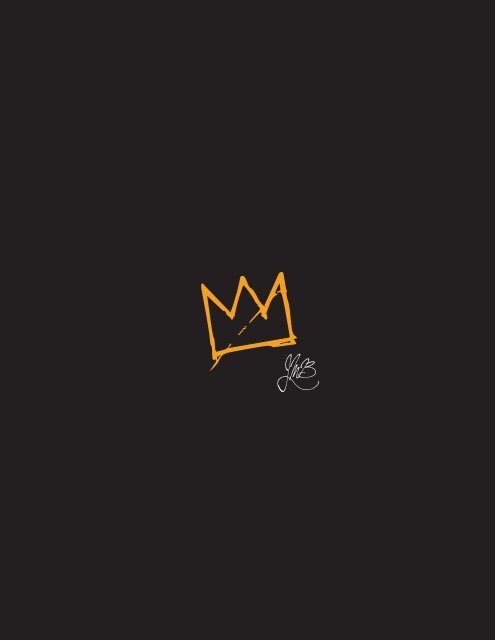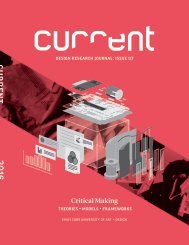Jean Michel Basquiat Monograph
Monograph Display and describing the works of Jean Michel Basquait
Monograph Display and describing the works of Jean Michel Basquait
Create successful ePaper yourself
Turn your PDF publications into a flip-book with our unique Google optimized e-Paper software.
JMB
<strong>Monograph</strong> displaying and<br />
describing the work of<br />
<strong>Jean</strong> <strong>Michel</strong> <strong>Basquiat</strong><br />
RA A<br />
CH<br />
2
DI<br />
NT<br />
ILD<br />
3
4
BIOGRAPHY 3<br />
EARLY YEARS 5<br />
SYNOPSIS 5<br />
ARTWORK 8<br />
Scull 11<br />
Notary 12<br />
Untitled 1982 15<br />
Arm and Hammer II 1985 17<br />
Fexible 1982 18<br />
Untitled History of the Black People 21<br />
KEY IDEAS 22<br />
PERSONAL PROBLEMS 22<br />
5
2
BIOGRAPHY<br />
3
4
SYNOPSIS<br />
<strong>Jean</strong>-<strong>Michel</strong> <strong>Basquiat</strong> was born on December 22, 1960, in Brooklyn, New<br />
York. He first attracted attention for his graffiti under the name “SAMO”<br />
in New York City. He sold sweatshirts and postcards featuring his artwork<br />
on the streets before his painting career took off. He collaborated with<br />
Andy Warhol in the mid-1980s, which resulted in a show of their work.<br />
<strong>Basquiat</strong> died on August 12, 1988, in New York City.<br />
EARLY YEARS<br />
Artist <strong>Jean</strong>-<strong>Michel</strong> <strong>Basquiat</strong> was born in Brooklyn, New York, on December<br />
22, 1960. With a Haitian-American father and a Puerto Rican mother, <strong>Basquiat</strong>’s<br />
diverse cultural heritage was one of his many sources of inspiration.<br />
A self-taught artist, <strong>Basquiat</strong> began drawing at an early age on sheets<br />
of paper his father, an accountant, brought home from the office. As he<br />
delved deeper into his creative side, his mother strongly encouraged to<br />
pursue artistic talents.<br />
<strong>Basquiat</strong> first attracted attention for his graffiti in New York City in the late<br />
1970s, under the name “SAMO.” Working with a close friend, he tagged<br />
subway trains and Manhattan buildings with cryptic aphorisms.<br />
In 1977, <strong>Basquiat</strong> quit high school a year before he was slated to graduate.<br />
To make ends meet, he sold sweatshirts and postcards featuring his artwork<br />
on the streets of his native New York.<br />
5
COMMERCIAL SUCCESS<br />
His rise coincided with the emergence of a new art movement, Noe-Expressionism,<br />
ushering in a wave of new, young and experimental artists<br />
that included Julian Schnabel and Susan Rothenberg.<br />
In the mid 1980s, <strong>Basquiat</strong> collaborated with famed pop artist Andy Warhol,<br />
which resulted in a show of their work that featured a series of corporate<br />
logos and cartoon characters.<br />
On his own, <strong>Basquiat</strong> continued to exhibit around the country and the<br />
world. In 1986, he traveled to Africa for a show in Abidjan, Ivory Coast.<br />
That same year, the 25-year-old exhibited nearly 60 paintings at the Kestner-Gesellschaft<br />
Gallery in Hanover, Germany—becoming the youngest<br />
artist to ever showcase his work there.<br />
6
7
8
I am not a black artist<br />
I am an artist<br />
9
10
Scull (1981) Acrylic and crayon on canvas- Private Collection<br />
SKULL<br />
An example of <strong>Basquiat</strong>’s early canvas-based work, Untitled (Skull)<br />
features a patchwork skull that seems the pictorial equivalent of<br />
Mary Shelley’s Frankenstein - a sum of incongruent parts. Suspended<br />
before a New York City subway map-like background, the skull<br />
is at once a contemporary graffitist’s riff on a long Western tradition<br />
of self portraiture and the “signature piece” of some anonymous,<br />
streetwise miscreant. <strong>Basquiat</strong>’s recent past as a gritty curbside<br />
peddler, virtually homeless floater, and occasional nightclub interloper<br />
are all equally stamped into this troubled three-quarter profile,<br />
making for a world-weary icon of the displaced Puerto-Rican<br />
and Haitian immigrant <strong>Basquiat</strong> forever seemed to remain even<br />
while successfully navigating the newly gentrified streets that were<br />
1980s SoHo.<br />
11
NOTARY<br />
12
Notary (1983) Acrylic and crayon on canvas- Private Collection<br />
A key work that serves as an example of <strong>Basquiat</strong>’s<br />
combinatory style is Notary, which he finished in March<br />
1983. The piece consists of a complex layering of images<br />
and symbols from Greek mythology, Roman history,<br />
and African tribal culture, among others. In the center<br />
of the painting is a black male torso, that includes<br />
both the black flesh and facial features and the internal<br />
workings, such as the neurological wiring in the head,<br />
the spine and several organs. The depiction is similar to<br />
that in Untitled (Head), only that in Notary the combination<br />
with other stylistic means adds to the immense<br />
complexity of the painting.<br />
13
Acrylic and oil paint stick on canvas - The Estate of <strong>Jean</strong>-<strong>Michel</strong> <strong>Basquiat</strong><br />
14
UNTITLED 1982<br />
Like a page pulled cleanly from a daily artist's journal, this untitled canvas<br />
features <strong>Basquiat</strong>'s personal iconography, some reminiscent of that of<br />
Paul Klee. Boldy appropriating images commonly associated with African<br />
art - a skull, a bone, an arrow - <strong>Basquiat</strong> modernizes them with his<br />
Noe-Expressionist style of thickly applied paint, rapidly rendered subjects,<br />
and scrawled linear characters, all of which float loosely across the<br />
pictorial field, as though hallucinatory. A white skull juts from the center<br />
of the ebony composition, vividly recalling a revered painter's tradition of<br />
the memento mori - a reminder of the ephemeral nature of all life and the<br />
body's eventual, merciless degeneration. <strong>Basquiat</strong> demonstrates in one<br />
concise "study" how he is able to carry on an ancient practice of painting<br />
"still life", all the while suggesting, as does a great jazz musician, that the<br />
artist's work was relatively effortless, if not completely improvisatory.<br />
15
Acrylic and silkscreen on canvas - Gallery Bruno Bischofberger AG
ARM AND HAMMER II 1985<br />
Typical of their collaboration, "Arm and Hammer II" demonstrates how<br />
<strong>Basquiat</strong> and Warhol would pass a work between them for their mutual<br />
intervention, like a game of chance happening, free association, and<br />
mutual inspiration. Warhol's characteristic employment of corporate logos<br />
and advertising copy as shorthand signs for the materialistic modern psyche<br />
is frequently overlaid by <strong>Basquiat</strong>'s only partially successful attempt<br />
to deface them, or otherwise "humanize" them, freehand, as though he<br />
were vainly railing his fist at a largely invisible and insidious monster.<br />
17
FLEXIBLE 1982<br />
Artwork description & Analysis: Flexible features two of <strong>Basquiat</strong>'s most<br />
famous motifs: the griot and the venerable crown. A sole black figure,<br />
half cadaver, half living entity, stares "blindly" at the viewer, its arms<br />
creating a closed circuit, perhaps a reference to spiritualized energy.<br />
With few distinguishing characteristics, the subject takes on the visage<br />
of the Everyman. At the same time, this is not just any figure, but one of<br />
African ethnicity and proud heritage a clear reference to <strong>Basquiat</strong>'s own<br />
identity (note the diagrammatic rendering of the figure's lungs and abdomen,<br />
reminiscent of the young <strong>Basquiat</strong>'s fascination for Gray's Anatomy<br />
sketches). Given that the griot is traditionally a kind of wandering philosopher,<br />
street performer, and social commentator all in one, it is probable<br />
that <strong>Basquiat</strong> saw himself in this role within the New York art world, one<br />
that nurtured his artistic success but also swiftly exploited it for material<br />
profit.<br />
18
Acrylic and oil paint stick on wood - The Estate of <strong>Jean</strong>-<strong>Michel</strong> <strong>Basquiat</strong><br />
19
Acrylic paint and oil paint stick on panel - The Estate of <strong>Jean</strong>-<strong>Michel</strong> <strong>Basquiat</strong>
UNTITLED HISTORY OF THE<br />
BLACK PEOPLE 1983<br />
As though he were reconstructing an epic history, or precedent, for his<br />
own ancestors’ arrival on the American continent, this expansive work of<br />
the early 1980s compresses together the relationship of Egypt to Africa,<br />
with references to more local centers of African-American music and<br />
greater southern culture, such as Memphis, Tennessee. At the center of<br />
the painting, <strong>Basquiat</strong> depicts a yellow Egyptian boat being guided down<br />
the Nile River by the god Osiris. Rife with visual and textual references<br />
to African history, the painting tackles a heady subject with a deceptively<br />
naive style. <strong>Basquiat</strong>’s late-period works feature multi-panel paintings,<br />
in the tradition of Renaissance religious triptychs, and canvases with<br />
exposed stretcher bars. Often the surfaces of these pieces are virtually<br />
consumed by their own freight of dense writing, collage,<br />
and abstruse imagery.<br />
21
KEY IDEAS<br />
• <strong>Basquiat</strong>’s work is one of the few examples of how an early 1980s American<br />
Punk, or graffiti-based and counter-cultural practice could become<br />
a fully recognized, critically embraced and popularly celebrated artistic<br />
phenomenon, indeed not unlike the rise of American Hip Hop during the<br />
same era.<br />
• Despite his work’s “unstudied” appearance, <strong>Basquiat</strong> very skillfully and<br />
purposefully brought together in his art a host of disparate traditions,<br />
practices, and styles to create a unique kind of visual collage, one deriving,<br />
in part, from his urban origins, and in another a more distant, African-Caribbean<br />
heritage.<br />
• For some critics, <strong>Basquiat</strong>’s swift rise to fame and equally swift and tragic<br />
death by drug overdose epitomizes and personifies the overly commercial,<br />
hyped up international art scene of the mid 1980s, a cultural<br />
phenomenon that for many observers was symptomatic of the largely<br />
artificial bubble economy of the era.<br />
• <strong>Basquiat</strong>’s work is an example of how American artists of the 1980s could<br />
reintroduce the human figure in their work after the wide success of Minimalism<br />
and Conceptual-ism, thus establishing a dialogue with the more<br />
distant tradition of 1950s Abstract Expressionism.<br />
PERSONAL PROBLEMS<br />
As his popularity soared, so did <strong>Basquiat</strong>’s personal problems. By the mid-<br />
1980s, friends became increasingly concerned by his excessive drug use.<br />
He became paranoid and isolated himself from the world around him for<br />
long stretches. Desperate to kick a heroin addiction, he left New York for<br />
Hawaii in 1988, returning a few months later and claiming to be sober.<br />
Sadly, he wasn’t. <strong>Basquiat</strong> died of a drug overdose on August 12, 1988,<br />
in New York City. He was 27 years old. Although his art career was brief,<br />
<strong>Jean</strong>-<strong>Michel</strong> <strong>Basquiat</strong> has been credited with bringing the African-American<br />
and Latino experience in the elite art world.<br />
22
23
THANKS FOR READING<br />
24
Knock Out Punch, Andy Warhol & <strong>Jean</strong>-<strong>Michel</strong> <strong>Basquiat</strong> Studio, New York July 10, 1985<br />
Silver Print Silver Gelatin Print Signed, titled, dated, and numbered on verso<br />
Photograph by Michael Halsband<br />
25
26
27
28

















